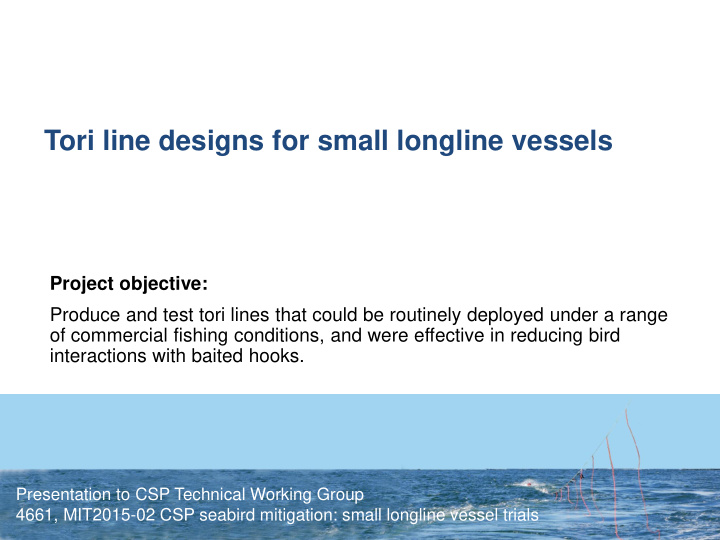



Tori line designs for small longline vessels Project objective: Produce and test tori lines that could be routinely deployed under a range of commercial fishing conditions, and were effective in reducing bird interactions with baited hooks. Presentation to CSP Technical Working Group 4661, MIT2015-02 CSP seabird mitigation: small longline vessel trials
Tori lines Well proven in the literature… But not much work has been done with small vessels.
State of play Observer coverage and liaison project indicate that uptake is poor • Skippers state a variety of reasons Regulations not particularly practical and untested on small vessels Less of.. More of..
The fleets Demersal longline snapper 1 or 2 sets per day, just before dawn, occasionally in afternoon 1000 - 7000 hooks per day Smaller vessels, lighter gear, shorter soaks, shorter trips, shallower sets
The fleets Demersal longline bluenose 1 - 4 sets a day, mostly at night, occasionally in afternoon. 500 - 2000 hooks per day Larger vessels, heavier gear, longer soaks, longer trips, deeper sets.
The fleets Pelagic longline 1 set a day, mostly at night, occasionally pre-dusk (SWO). 800-1200 hooks per day Floating gear, lots floats, long snoods. Some weighted.
Regulations - pelagic longliners ACAP recommendations (vessels <35 m) 75 m aerial extent 7 m high over the vessel stern Brightly coloured streamers may be short or long, or both. Short streamers at 1m intervals or long streamers at 5 m intervals NZ regulations: 75 m aerial extent 6 m attachment height Streamers reaching the surface of the water every 5 m for the first 55 m. Streamers of a minimum length of 1 m should also be attached along the whole aerial extent (75 m). Streamers must be attached by swivels.
Regulations - demersal longliners ACAP recommendations (not split by vessel size) 150 m total length 7 m attachment height Streamers reaching the sea surface every 5 m A suitable towed device NZ regulations (vessels < 20 m) 50 m aerial extent 5 m attachment height Streamers reaching the surface of the water every 5 m
Research approach Select vessels Design and build tori lines / poles Testing and modification Measure performance and efficacy • Bird abundance and behaviour around tori lines • Tangle / loss rate • Skipper feedback • TDR data – how deep are hooks at end of tori line?
Tori line design – aerial section 0 5 1 0 1 5 2 0 2 5 3 0 3 5 4 0 4 5 5 0 5 5 6 0 6 5 7 0 7 5 drag se ction streamer 5 mm plastic tubing holo graphic tape material 9 mm plastic tubing black plastic tape
Tori line design – drag section Snapper demersal longliners 30 or 40 m 9 mm diameter rope, series of floats and a towed object Bluenose demersal longliners 100 m 9 mm rope section, single towed object Pelagic longliners 100 m 9 mm rope or 250 m 5 mm diameter monofillament nylon
Tori poles Two pole types tested • 3.9 m 62 mm diameter carbon • 5.0 m 52 mm fibreglass Different installation for each vessel Moveable attachment point Some vessels had existing high point
Tori poles
Tori poles
Tension release Repeatable breakaway tension Pre-set between 5 and 30 kg
Results summary • 22 vessels • 75 m aerial extent feasible on surface liners • 50 m aerial extent feasible on snapper liners • 75 m aerial section feasible for larger snapper liners • 50 m aerial extent achieved on two bluenose liners • One bluenose vessel found a long tori line impractical
Tori line observations Tori Line Observation Form Trip Set Bait 1 % salted (y/n) Bait 2 % salted (y/n) Wind speed Setting speed Swell Observer eye (knots) (knots) height (m) height (m) Bird count by species Visibility score Wind direction Swell direction OBSERVATION PERIOD 1 ) (feel free to use group codes 5 min count of dives for petrels and shearwaters Species only, excluding cape pigeons and storm petrels Total < 200m Start time End time Aerial section Aerial section Drag section Drag section Behind tori line Behind tori line
Tori line observations
Tori line observations 100 100 Count of petrels and shearwaters Abundance Vessel 12 Abundance Vessel 13 80 80 60 60 40 40 20 20 0 0 Alongside Behind Alongside Behind Count of birds putting their head under water 80 Heads under water Vessel 12 80 Heads under water Vessel 13 60 60 40 40 20 20 0 Alongside Behind Alongside Behind
Sink rate data pelagic gear 38g weight at 0.5 m from hook Indicative of all hooks n = 22 grey = interquartile range
Sink rate data snapper gear 3.5 kg every 25 hooks Can increase weight if birds are present Indicative of slowest sinking hooks (between weights) n = 8 Grey = interquartile range
Conclusions / Recommendations Regulations • Incorporate lessons learnt • Pelagic 75 m aerial extent is feasible • Snapper 50 m feasible, 75 m is suggested for those setting faster • Bluenose 50 m feasible in some cases – suggest vessel by vessel approach Compliance • Proactive
Conclusions / Recommendations Supply tori setups to all small longliners Continue to learn • Tori observations on all observer trips • Continue to gather feedback from skippers • Promote tori lines as a part of successful mitigation approach
Acknowledgements Skippers / Owners / Crew Engineers Kilwell Fibretube Observers CSP team
Recommend
More recommend